The topic is called: Electric power. Electric current power. I would like to reveal in it this concept in a simple and understandable form. And, perhaps, before talking about electrical power, we should first define the concept of power in the general sense. Typically, when people talk about power, they mean some kind of “force” that an object (a powerful electric motor) or an action (a powerful explosion) has. But as we know from school physics, force and power are different concepts, but they have a dependence.
Initially, power (N) is a characteristic related to a certain event (action), and if it is tied to a certain object, then the concept of power is also conditionally correlated with it. Any physical action implies the influence of force. The force (F) with which a certain path (S) was traveled will be equal to the work done (A). Well, the work done in a certain time (t) will be equated to power.
Power is a physical quantity that is equal to the ratio of the work performed over a certain period of time to the same period of time. Since work is a measure of energy change, we can also say this: power is the rate of energy conversion of the system.
Understanding the concept mechanical power, let's move on to considering electrical power (electric current power). As you should know, U is the work done when moving one coulomb, and the current I is the number of coulombs passing in 1 second. Therefore, the product of current and voltage shows the total work done in 1 second, that is, electrical power or electrical current power.
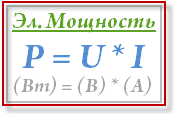
Analyzing the above formula, we can draw a very simple conclusion: since electric power“P” equally depends on the current “I” and on the voltage “U”, therefore, the same electrical power can be obtained either with a high current and low voltage, or, conversely, with a high voltage and low current (This is used when transmitting electricity over remote distances from power plants to places of consumption, through transformer conversion at step-up and step-down power substations).
Active electrical power (this is power that is irrevocably converted into other types of energy - thermal, light, mechanical, etc.) has its own unit of measurement - W (Watt). It is equal to 1 volt times 1 ampere. In everyday life and in production, it is more convenient to measure power in kW (kilowatts, 1 kW = 1000 W). At power plants, larger units are used - mW (megawatts, 1 mW = 1000 kW = 1,000,000 W).
Reactive electrical power is a quantity that characterizes this type of electrical load that is created in devices (electrical equipment) by energy fluctuations (inductive and capacitive in nature) electrical magnetic field. For ordinary alternating current it is equal to the product of the operating current I and the voltage drop U by the sine of the phase angle between them: Q = U*I*sin(angle). Re active power has its own unit of measurement called VAR (volt-ampere reactive). Denoted by the letter "Q".
In simple language, active and reactive electrical power can be expressed using an example as follows: we have an electrical device that has heating elements and an electric motor. Heating elements are usually made of high resistance material. When an electric current passes through the heating element's spiral, the electrical energy is completely converted into heat. This example is typical of active electrical power.

The electric motor of this device has a copper winding inside. It represents inductance. And as we know, inductance has the effect of self-induction, and this contributes to the partial return of electricity back to the network. This energy has some offset in current and voltage values, which causes Negative influence to the power grid (further overloading it).
Capacitance (capacitors) also has similar abilities. It is capable of accumulating charge and releasing it back. The difference between capacitance and inductance lies in the opposite displacement of the values of current and voltage relative to each other. This energy of capacitance and inductance (phase-shifted relative to the value of the supply network) will, in fact, be reactive electrical power.
We will talk in more detail about the properties of reactive power in the corresponding article, and at the end of this topic I would like to say about the mutual influence of inductance and capacitance. Since both inductance and capacitance have the ability to phase shift, but each of them does this with the opposite effect, this property is used to compensate for reactive power (increasing the efficiency of power supply).
P.S. Speaking about the electrical power of electrical devices, we must remember that it is limited by the nominal and maximum values of current and voltage, and these limitations already depend on the material, operating frequencies, manufacturing technology and other factors.
Each electrical appliance has its own power. Information about it can be found on the case electric kettle and a hair dryer, on the bulb of an electric incandescent lamp and on the top cover of a vacuum cleaner.
It is known that these kilowatts and watts not only directly affect the readings of the electric meter, but also the amount of current in the electrical conductors. And excessive current may cause tripping circuit breaker, or burning of contacts and damage to wires.
Therefore, knowing the relationship between the power consumed by a device from the network and the electric current that it causes in the same network will not be superfluous. Moreover, on the housing of the already mentioned sockets it is the maximum current that is indicated, and not the electrical power.
Determination of electrical power. So, from the physics course we know that power is the work done per unit of time. That is, just as a car, having speed, covers a certain distance every hour (km/hour), so any switched-on device does some specific work in the same hour (J/hour=W).
But the numbers indicated on the body of the electric kettle do not indicate how much water it can boil in certain time, but about how much energy it will consume from the network over the same time period.
This energy is spent moving electrons in a conductor. Therefore, for one electron with a unit charge it is equal to the network voltage:
After all, the tension between two points is the work required to move unit charge from the first to the second point. Full work(energy) required to move the entire mass of electrons is the product of voltage and the number of electrons in the circuit of our teapot:
A_full=U*Q;
And since power is work per unit of time, we get the following expression for it:
Р=(U*Q)/t;
But the number of electrons “flowing” through the cross section of a conductor per unit time (Q/t) is well known to us electricity. It turns out that we don’t need to stand with a stopwatch and count electrons - it’s enough to know the current and voltage, and the power can be found as their product:
In practice, as written above, more often you have to deal not with the problem of determining power, but with the problem of calculating the current based on the known rated power of the device and the network voltage. Thus, it is possible to determine the current consumed by the device and correlate it with the rating of the outlet and circuit breaker.
For example, for an electric kettle with a power of two kilowatts, intended for inclusion in a household electrical network, the current can be calculated as follows:
I=P/U=(2*1000)/220=9 amperes;
Obviously, you cannot use a six-amp plug connector to connect such a kettle.
However, it should be noted that these relationships between current and power only apply when the current and voltage are in phase. This is the case for almost all powerful household electrical appliances, but it is necessary to keep in mind that if there is a large inductance or capacitance in the circuit, the given formulas will “lie”.
An example would be AC electric motors, in which the active power will be expressed as follows:
Р=I*U*cosφ;
Where cosφ- power factor, usually equal to 0.6-0.8 units for electric motors.
When determining the parameters of any device in three-phase network 380 volts, we can assume that its power is the sum of the power of three phases, in each of which a phase current flows and a phase voltage is applied.
Here's an example: a three-phase boiler with a power of 3 kW consumes one kilowatt in each phase. The phase current will be equal to:
I=P/U_ф =(1*1000)/220=4.5 amperes.
From a client letter:
Tell me, for God's sake, why the power of the UPS is indicated in Volt-Amps, and not in the usual kilowatts. It's very stressful. After all, everyone has long been accustomed to kilowatts. And the power of all devices is mainly indicated in kW.
Alexei. June 21, 2007
IN technical specifications of any UPS, the total power [kVA] and active power [kW] are indicated - they characterize the load capacity of the UPS. Example, see photos below:
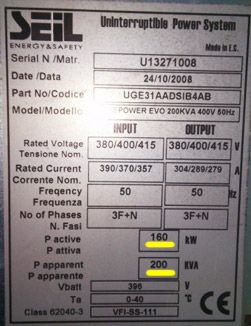 |
The power of not all devices is indicated in W, for example:
- The power of transformers is indicated in VA:
http://www.mstator.ru/products/sonstige/powertransf (TP transformers: see appendix)
http://metz.by/download_files/catalog/transform/tsgl__tszgl__tszglf.pdf (TSGL transformers: see appendix) - Capacitor power is indicated in Vars:
http://www.elcod.spb.ru/catalog/k78-39.pdf (capacitors K78-39: see appendix)
http://www.kvar.su/produkciya/25-nizkogo-napraygeniya-vbi (UK capacitors: see appendix) - For examples of other loads, see the appendices below.
The power characteristics of the load can be precisely specified by one single parameter (active power in W) only for the case direct current, since in a DC circuit there is only one type of resistance - active resistance.
The power characteristics of the load for the case of alternating current cannot be accurately specified by one single parameter, since there are two different types resistance – active and reactive. Therefore, only two parameters: active power and reactive power accurately characterize the load.
The operating principles of active and reactive resistance are completely different. Active resistance – irreversibly transforms electrical energy into other types of energy (thermal, light, etc.) - examples: incandescent lamp, electric heater (paragraph 39, Physics grade 11 V.A. Kasyanov M.: Bustard, 2007).
Reactance - alternately accumulates energy and then releases it back into the network - examples: capacitor, inductor (paragraph 40,41, Physics 11th grade V.A. Kasyanov M.: Bustard, 2007).
Further in any textbook on electrical engineering you can read that active power (dissipated by active resistance) is measured in watts, and reactive power (circulating through reactance) is measured in vars; Two more parameters are also used to characterize the load power: full power and power factor. All these 4 parameters:
- Active power: designation P, unit of measurement: Watt
- Reactive power: designation Q, unit of measurement: VAR(Volt Ampere reactive)
- Apparent power: designation S, unit of measurement: VA(Volt Ampere)
- Power factor: symbol k or cosФ, unit of measurement: dimensionless quantity
These parameters are related by the relations: S*S=P*P+Q*Q, cosФ=k=P/S
Also cosФ called power factor ( Power Factor – PF)
Therefore, in electrical engineering, any two of these parameters are specified to characterize power, since the rest can be found from these two.
For example, electric motors, lamps (discharge) - in those. data indicated P[kW] and cosФ:
http://www.mez.by/dvigatel/air_table2.shtml (AIR engines: see appendix)
http://www.mscom.ru/katalog.php?num=38 (DRL lamps: see appendix)
(examples of technical data different loads see appendix below)
It's the same with power supplies. Their power (load capacity) is characterized by one parameter for DC power supplies - active power (W), and two parameters for sources. AC power supply. Typically these two parameters are apparent power (VA) and active power (W). See, for example, the parameters of the diesel generator set and the UPS.
Most office and household appliances, active (no or little reactance), therefore their power is indicated in Watts. In this case, when calculating the load, the UPS power value in Watts is used. If the load is computers with power supplies (PSUs) without input power factor correction (APFC), laser printer, refrigerator, air conditioner, electric motor (for example submersible pump or a motor as part of a machine), fluorescent ballast lamps, etc. - all outputs are used in the calculation. UPS data: kVA, kW, overload characteristics, etc.
See electrical engineering textbooks, for example:
1. Evdokimov F. E. Theoretical basis electrical engineering. - M.: Publishing center "Academy", 2004.
2. Nemtsov M.V. Electrical engineering and electronics. - M.: Publishing center "Academy", 2007.
3. Chastoedov L. A. Electrical engineering. - M.: Higher School, 1989.
Also see AC power, Power factor, Electrical resistance, Reactance http://en.wikipedia.org
(translation: http://electron287.narod.ru/pages/page1.html)
Application
Example 1: the power of transformers and autotransformers is indicated in VA (Volt Amperes)
http://metz.by/download_files/catalog/transform/tsgl__tszgl__tszglf.pdf (TSGL transformers)
| Single-phase autotransformers |
|
||
| TDGC2-0.5 kVa, 2A | AOSN-2-220-82 | ||
| TDGC2-1.0 kVa, 4A | Latr 1.25 | AOSN-4-220-82 | |
| TDGC2-2.0 kVa, 8A | Latr 2.5 | AOSN-8-220-82 | |
| TDGC2-3.0 kVa, 12A | |||
| TDGC2-4.0 kVa, 16A | |||
| TDGC2-5.0 kVa, 20A | AOSN-20-220 | ||
| TDGC2-7.0 kVa, 28A | |||
| TDGC2-10 kVa, 40A | AOMN-40-220 | ||
| TDGC2-15 kVa, 60A | |||
| TDGC2-20 kVa, 80A | |||
http://www.gstransformers.com/products/voltage-regulators.html (LATR / laboratory autotransformers TDGC2)
Example 2: the power of capacitors is indicated in VAR (Volt Amperes reactive)
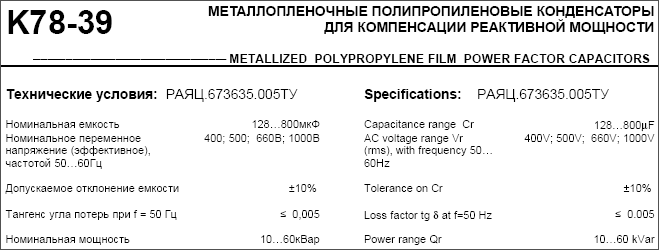 |
http://www.elcod.spb.ru/catalog/k78-39.pdf (capacitors K78-39)
 |
http://www.kvar.su/produkciya/25-nizkogo-napraygeniya-vbi (UK capacitors)
Example 3: technical data for electric motors contains active power (kW) and cosF
For loads such as electric motors, lamps (discharge), computer power supplies, combined loads, etc. - the technical data indicates P [kW] and cosФ (active power and power factor) or S [kVA] and cosФ (apparent power and power factor) power).
http://www.weiku.com/products/10359463/Stainless_Steel_cutting_machine.html
(combined load - machine plasma cutting steel / Inverter Plasma cutter LGK160 (IGBT)
http://www.silverstonetek.com.tw/product.php?pid=365&area=en (PC power supply)
Appendix 1
If the load has a high power factor (0.8 ... 1.0), then its properties approach those of a resistive load. Such a load is ideal both for the network line and for power sources, because does not generate reactive currents and powers in the system.
Therefore, many countries have adopted standards regulating the power factor of equipment.
Addendum 2
Single-load equipment (for example, power supply PC) and multi-component combined (for example, milling industrial machine, which contains several motors, a PC, lighting, etc.) have low power factors (less than 0.8) of internal units (for example, a PC power supply rectifier or an electric motor have a power factor of 0.6 .. 0.8). Therefore, nowadays most equipment has a power factor correction input unit. In this case, the input power factor is 0.9 ... 1.0, which corresponds to regulatory standards.
Appendix 3: Important Note Regarding UPS Power Factor and Voltage Stabilizers
The load capacity of the UPS and diesel generator set is normalized to a standard industrial load (power factor 0.8 with an inductive nature). For example, UPS 100 kVA / 80 kW. This means that the device can power a resistive load maximum power 80 kW, or mixed (reactive-reactive) load of maximum power 100 kVA with an inductive power factor of 0.8.
With voltage stabilizers the situation is different. For the stabilizer, the load power factor is indifferent. For example, a 100 kVA voltage stabilizer. This means that the device can supply an active load with a maximum power of 100 kW, or any other (purely active, purely reactive, mixed) power of 100 kVA or 100 kVAr with any power factor of a capacitive or inductive nature. Note that this is true for a linear load (without higher harmonic currents). With large harmonic distortions of the load current (high SOI), the output power of the stabilizer is reduced.
Addendum 4
Illustrative examples of pure active and pure reactive loads:
- A 100 W incandescent lamp is connected to an alternating current network of 220 VAC - everywhere in the circuit there is conduction current (through the wire conductors and the tungsten filament of the lamp). Load (lamp) characteristics: power S=P~=100 VA=100 W, PF=1 => all electrical power is active, which means it is completely absorbed in the lamp and converted into heat and light power.
- A 7 µF non-polar capacitor is connected to an alternating current network of 220 VAC - there is a conduction current in the wire circuit, and a bias current flows inside the capacitor (through the dielectric). Characteristics of the load (capacitor): power S=Q~=100 VA=100 VAr, PF=0 => all electrical power is reactive, which means it constantly circulates from the source to the load and back, again to the load, etc.
Addendum 5
To indicate the predominant reactance (inductive or capacitive), the power factor is assigned the sign:
+ (plus)– if the total reactance is inductive (example: PF=+0.5). The current phase lags behind the voltage phase by an angle Ф.
- (minus)– if the total reactance is capacitive (example: PF=-0.5). The current phase advances the voltage phase by angle F.
Appendix 6
Additional questions
Question 1:
Why do all electrical engineering textbooks use imaginary numbers/quantities when calculating AC circuits (for example, reactive power, reactance, etc.) that do not exist in reality?
Answer:
Yes, all individual quantities in the surrounding world are real. Including temperature, reactance, etc. The use of imaginary (complex) numbers is only a mathematical technique that facilitates calculations. The result of the calculation is a necessarily real number. Example: reactive power of a load (capacitor) of 20 kVAr is a real energy flow, that is, real Watts circulating in the source-load circuit. But in order to distinguish these Watts from the Watts irretrievably absorbed by the load, they decided to call these “circulating Watts” reactive Volt Amperes.
Comment:
Previously, only single quantities were used in physics, and when calculating, all mathematical quantities corresponded to the real quantities of the surrounding world. For example, distance equals speed times time (S=v*t). Then, with the development of physics, that is, as more complex objects were studied (light, waves, alternating electric current, atom, space, etc.), such a thing appeared a large number of physical quantities, that it became impossible to count each one separately. This is not only a problem of manual calculation, but also a problem of compiling computer programs. To solve this problem, close single quantities began to be combined into more complex ones (including 2 or more single quantities), subject to transformation laws known in mathematics. This is how scalar (single) quantities (temperature, etc.), vector and complex dual quantities (impedance, etc.), triple vector quantities (magnetic field vector, etc.), and more complex quantities appeared - matrices and tensors (dielectric constant tensor, tensor Ricci and others). To simplify calculations in electrical engineering, the following imaginary (complex) dual quantities are used:
- Total resistance (impedance) Z=R+iX
- Apparent power S=P+iQ
- Dielectric constant e=e"+ie"
- Magnetic permeability m=m"+im"
- and etc.
Question 2:
The page http://en.wikipedia.org/wiki/Ac_power shows S P Q Ф on a complex, that is, imaginary / non-existent plane. What does all this have to do with reality?
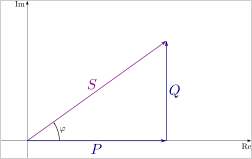 |
Answer:
It is difficult to carry out calculations with real sinusoids, therefore, to simplify the calculations, use a vector (complex) representation as in Fig. higher. But this does not mean that the S P Q shown in the figure are not related to reality. Real values of S P Q can be presented in in the usual form, based on measurements of sinusoidal signals with an oscilloscope. The values of S P Q Ф I U in the alternating current circuit “source-load” depend on the load. Below is an example of real sinusoidal signals S P Q and Ф for the case of a load consisting of active and reactive (inductive) resistances connected in series.
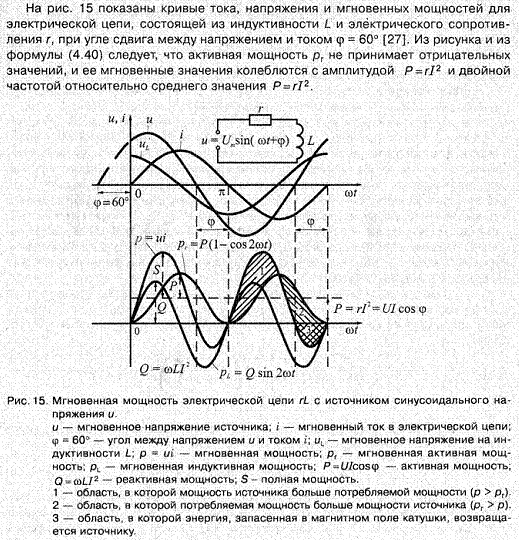 |
Question 3:
Ordinary current clamps and a multimeter measured the load current of 10 A, and the voltage on the load is 225 V. Multiply and get the load power in W: 10 A · 225V = 2250 W.
Answer:
You have obtained (calculated) the total load power of 2250 VA. So your answer will only be valid if your load is purely resistive, then indeed Volt Ampere equal to Watt. For all other types of loads (for example, an electric motor) - no. To measure all the characteristics of any arbitrary load, you must use a network analyzer, for example APPA137:
 |
See further reading, for example:
Evdokimov F. E. Theoretical foundations of electrical engineering. - M.: Publishing center "Academy", 2004.
Nemtsov M.V. Electrical engineering and electronics. - M.: Publishing center "Academy", 2007.
Chastoedov L. A. Electrical engineering. - M.: Higher School, 1989.
AC power, Power factor, Electrical resistance, Reactance
http://en.wikipedia.org (translation: http://electron287.narod.ru/pages/page1.html)
Theory and calculation of low power transformers Yu.N. Starodubtsev / RadioSoft Moscow 2005 / rev d25d5r4feb2013

